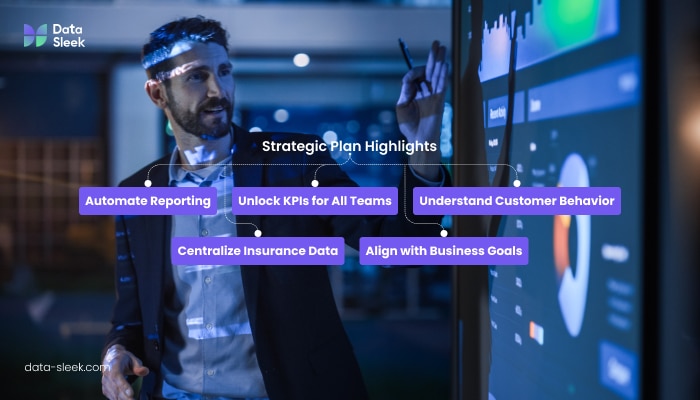The construction industry is inherently high-risk, which makes data management for construction insurance providers a must. Tradesman, a leader in construction insurance, has long been helping contractors and tradespeople protect their operations from a wide range of risks and legal liabilities.
However, as the company grew, its internal data systems lagged behind. Disparate tools, manual data entry and reporting, and limited insight into key performance indicators (KPIs) make it difficult to make fast, data-driven decisions.
To bring their data operations up to speed with the current demand, Tradesman partnered with Data-Sleek to overhaul its approach to data management for construction insurance, primarily by pulling and processing its data through a single data management system.
The Problem: Siloed Tools and Slowed Decisions
Siloed tools and disparate data management systems are among the top problems Trademan’s teams faced in their daily operations. This lead to slow decisions and data being trapped in silos, resulting in teams spending too much of their time pulling various reports manually.
In short, the company had data, but the data lacked clarity and structure. This led to a series of pain points, such as:
- Manual, time-consuming data reporting processes
- Difficulty consolidating performance metrics into a single view
- Inflexible dashboards that didn’t support executive needs
- Missed opportunities to spot customer trends and act quickly
- Inefficient insurance data operations that slowed decision-making
Starting With Strategy, Not Just Software
Rather than jumping straight into the technical implementation of data management for construction insurance, we began our work with Tradesman by asking a simple question:
“What business value do you want your data to deliver?”
Through a series of collaborative strategy sessions, we helped Tradesman’s leadership team identify their core goals:
- Cut down reporting time
- Empower teams to make faster decisions
- Increase visibility into key performance indicators (KPIs)
- Reduce friction around accessing insights
- Establish a sustainable construction insurance data strategy
With those goals in mind, we built a roadmap rooted in real outcomes, not just new tools.
The Solution: A Unified, Scalable Data Framework
To bring Tradesman’s vision to life, we implemented a robust, cloud-based data stack customized to their specific workflows and business priorities.
Unified Data Architecture
To support its construction insurance data strategy, Tradesman needed to ensure data consistency. Thus, we developed a unified, cloud-based data architecture that’s specifically tailored to Tradesman’s unique operations.

This created a single source of data (single source of truth) that effectively eliminated all inconsistencies caused by the use of legacy and disparate systems, and enabled access to business-critical metrics and key performance indicators.
Automated Data Flows
Using Fivetran and dbt for data transformation, we automated insurance data collection and transformation from different systems, thus ensuring data accuracy and consistency. This significantly reduces the margin of error within the data, especially if manual data entries are eliminated.
Custom Dashboards Built for Business Teams
Based on Tradesman’s business needs, we also developed intuitive dashboards through Tableau dashboards for insurance. These now include:
- Interactive filters and role-based views
- Fully printable, presentation-ready formats
- Tailored insights for leadership, operations, and support staff
Empowering Teams Through Training
We provided Tradesman’s teams with training, enabling them to confidently use insurance business intelligence tools like Tableau dashboards and dbt—thus enabling faster, data-driven decisions, while reducing dependency on analysts for everyday needs.
The Impact: Leaner, Smarter Operations
Since launching the new data framework, Tradesman has seen measurable improvements across its business. These improvements include:
- Significantly faster reporting
- Improved visibility into KPIs
- More confident, data-literate teams
- Less time spent on manual tasks
- A scalable system ready for future growth
- Enhanced insurance data operations for greater efficiency
By aligning data to real business needs, Tradesman is no longer just collecting information—it’s acting on it, with clarity, precision, and speed. Their unified data architecture now serves as the foundation for all its strategic decisions.
Final Thoughts: Why Business-Led Data Strategy Works
The Tradesman story is a great example of what happens when a construction insurance data strategy starts with business value. Instead of leading with tools, we led with questions: What decisions need to be faster? What metrics matter most? What’s holding your team back?
When those questions guide the build, the result isn’t just better data—it’s a better business. With the right insurance business intelligence tools in place, companies can transform how they operate, compete, and grow.
About Data-Sleek
At Data-Sleek, we help companies turn complex data ecosystems into engines of clarity and growth. Whether you’re scaling fast or untangling legacy systems, we deliver insurance data operations solutions that prioritize business value from day one.

Learn more at http://data-sleek.com/
Frequently Asked Questions (FAQ)
Here are some of the frequently asked questions regarding data management for construction insurance:
What is data management for construction insurance?
Data management for construction insurance refers to organizing, storing, and analyzing business-critical information, with the aim of supporting better decision-making, compliance, and operational efficiency. This data usually includes claims data, customer engagement, and risk metrics.
Why was Tradesman struggling with its data operations?
Tradesman faced challenges like siloed systems, slow reporting processes, and limited visibility into performance metrics. These issues made it difficult for teams to act quickly or gain insights into customer behavior and risk exposure.
What tools were used to improve Tradesman’s data management?
Data-Sleek implemented a modern cloud-based data stack, including Snowflake data warehouse for insurance for centralized storage, Fivetran for automated data ingestion, dbt for transformation, and Tableau dashboards for insurance companies for accessible, role-based reporting.
How does insurance data transformation impact decision-making?
Insurance data transformation turns raw inputs into structured insights. For Tradesman, it meant clearer KPI visibility, faster reporting, and a new level of business agility.
Is this type of unified data architecture solution scalable for other insurance providers?
Yes, the insurance business intelligence components can be customized based on each company’s specific needs. Unified data architectures are highly scalable and adaptable to meet the business needs of all construction providers or just about any organization looking to modernize its data operations for greater clarity, speed, and efficiency.



